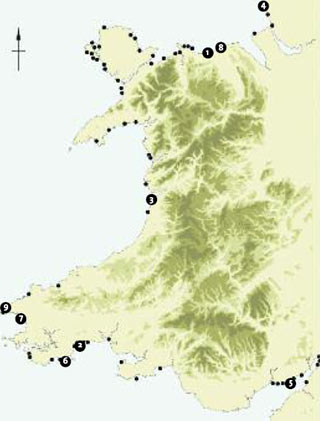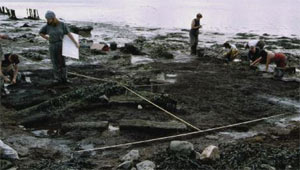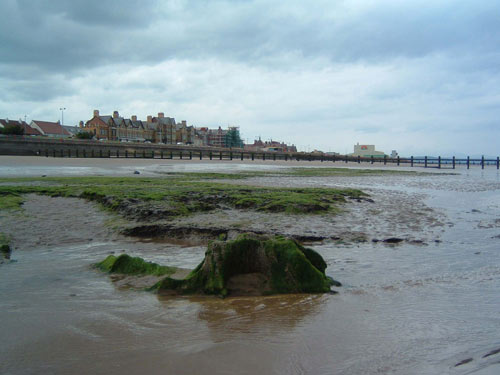
Borth Beach, Ceredigion (Photo Nigel Nayling)
The distribution of ancient submerged forests in Wales |
|
 |
1 Abergele |
 |
The cleaning and planning of the submerged
forest at Goldcliff East on, the Severn Estuary in 2002 |
Cantre'r Gwaelod |
The lost lands of West Wales that lie off CardiganBay are handed down in folklore as the story of the Lowland Hundred or Cantre’r Gwaelod. There are several versions of the myth with the oldest recorded, the poem ‘Seithennin’ or ‘Boddi Maes Gwyddneu’, dating to around 1250. The tale tells of a country defended from the sea by a wall or dyke. When the floodgates are negligently left open one night, Cantre’r Gwaelod is flooded and lost beneath the waves. ‘When waves crashed on the sea-shore (from Clychau Cantre'r Gwaelod JJ Williams (1869–1954)) |
The remnants of fallen trees and stumps around the coastline are perhaps the most enticing evidence we have for the existence of long lost lands. They offer a tangible link to our ancestral landscape and have helped inspire numerous myths and legends of cities and countries swept away by the sea. Indeed, before their true nature was understood, they were believed to be the result of the biblical flood and were referred to as ‘Noah’s Trees’. They are revealed at low tide at many locations around the Welsh coast, from Rhyl and Abergele in the north, Borth and Newgale in the west to Amroth and Newport in the south. The preserved stumps of willow, hazel, oak, pine and birch are evidence of former woods and forests swamped by the encroaching tides and irrefutable testimony to the devastating effect of climate change. The tree stumps are rooted in peat levels lying below the marine sand and have been preserved by the continuous waterlogged conditions. The sites around the Welsh coast do not represent a single phase of inundation. The radiocarbon dates from the trees at Ynyslas, Cardigan Bay, suggest that they died around 5,500 years ago, while those just over a kilometre to the south at Borth died some 2,000 years later. The remains of animals have been excavated from the deposits around the tree stumps, including auroch, red deer and brown bear from Whitesands and pig from Lydstep, both in Pembrokeshire. Although observed and commented upon through the centuries, including by Gerald of Wales in 1188 and Samuel Pepys in 1665 no serious study of the submerged forests was made until 1913 when Clement Reid, a geologist, published a book on the subject. His Submerged Forests was the first survey to put these trees into a wider archaeological context and to argue conclusively that they were the result of a rise in sea level. Reid’s work to identify the extent of submerged land led him to study the area east of the Humber, where bones from extinct animals had long been dredged up by fishing trawlers. One area of the North Sea in particular caught his attention - Dogger Bank.
|
